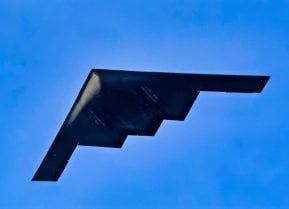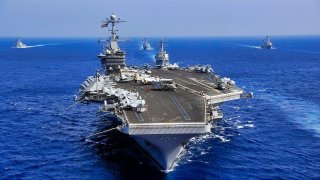CVV: The Medium Aircraft Carrier the U.S. Navy Never Built
The concept of the CVV, a medium-sized aircraft carrier proposed over 50 years ago during Admiral Enzo Zumwalt's tenure as chief of naval operations, is gaining renewed interest in the U.S. Navy.
Summary: The concept of the CVV, a medium-sized aircraft carrier proposed over 50 years ago during Admiral Enzo Zumwalt's tenure as chief of naval operations, is gaining renewed interest in the U.S. Navy. Initially designed as a conventionally powered vessel to carry 55 to 65 fighter jets and helicopters at a lower cost than Nimitz-class carriers, the CVV idea was shelved with the increase in the military budget under President Ronald Reagan. However, contemporary challenges, particularly Anti-Access/Area Denial (A2/AD) strategies by U.S. adversaries, have led to reconsideration of similar concepts. The Navy is exploring "Lightning Carriers" that can operate F-35B Lightning II stealth fighters, offering a versatile and risk-mitigated approach to maintain operational capability in contested regions like the South China Sea and near Taiwan, indicating a potential revival of the CVV concept to adapt to modern strategic needs.
CVV: Could Medium-Sized Carriers Be the Answer to the Navy's A2/AD Challenge?
The U.S. Navy fields the most aircraft carriers in the world. The service’s 11 supercarriers are complemented by several other warships that can double as light carriers when needed.
The concept of the light aircraft carrier isn’t new. But the Navy has a mixed relationship with it, usually preferring fewer but stronger carriers for its fleet.
More than 50 years ago, the Navy came close to fielding an interesting carrier.
The CVV Concept
In the 1970s, the Navy was undergoing a major change. Adm. Enzo Zumwalt was the chief of naval operations, the top officer in the Navy, and he was pushing for a naval force of more but smaller warships.
As part of that push for numbers, Navy officials circulated the idea of an interim aircraft carrier. The Aircraft Carrier (Medium) CVV concept envisioned a conventionally powered warship that would be cheaper and smaller than the Nimitz-class supercarriers that were then under construction.
With a displacement of more than 62,000 tons, a complement of about 4,000 men, and the ability to carry 55 to 65 fighter jets and helicopters, the CVV concept promised to diversify the Navy’s fleet.
A single prototype was planned, and the Navy released artistic impressions of the ship. But the CVV concept perished when Ronald Reagan came to the presidency and unleashed the military’s budget. With money no longer a limiting factor, the Navy could just build more Nimitz-class aircraft carriers – vessels that could carry almost 100 aircraft and were also nuclear-powered.
All of this took place more than 40 years ago, but today’s challenges might revive the CVV concept.
Countering Adversary Strategies
The idea for a CVV fleet might have died an inglorious death in the planning boards of the Navy Yard in Washington, D.C., but the concept behind the medium aircraft carrier lives on.
For several years now, U.S. adversaries have been developing Anti-Access/Aerial Denial (A2/AD) capabilities that aim to restrict America’s Nimitz- and Ford-class supercarriers from contested waters. Indeed, a well-placed hypersonic munition could damage, destroy, or sink a multi-billion dollar aircraft carrier like the USS Gerald R. Ford, which cost $13 billion.
The Navy is looking for ways to counter A2/AD capabilities and continue to operate without restriction close to geopolitically important regions such as Taiwan, the South China Sea, and the Black Sea.
One of the concepts under development is that of the “Lightning Carrier.” The concept is similar to the CVV. A cheaper, smaller aircraft carrier comes with less risk for military planners, and it offers more solutions. The Navy has been pairing amphibious assault ships with the right aircraft – AV-8B Harrier attack jets and F-35B Lightning II stealth fighter jets. These aircraft have Short Take-off, Vertical Landing capabilities, meaning they can take off and land like helicopters.
As the possibility of a near-peer conflict in the Indo-Pacific increases, the concept of the medium aircraft carrier is becoming more enticing to Navy planners.
About the Author
Stavros Atlamazoglou is a seasoned defense journalist specializing in special operations and a Hellenic Army veteran (national service with the 575th Marine Battalion and Army HQ). He holds a BA from Johns Hopkins University and an MA from the Johns Hopkins School of Advanced International Studies (SAIS). His work has been featured in Business Insider, Sandboxx, and SOFREP. Email the author: [email protected].


